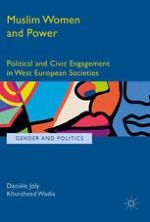2017 | OriginalPaper | Chapter
4. Migrations, Demographics and Socio-Economic Profiles
Authors : Danièle Joly, Khursheed Wadia
Published in: Muslim Women and Power
Publisher: Palgrave Macmillan UK
Activate our intelligent search to find suitable subject content or patents.
Select sections of text to find matching patents with Artificial Intelligence. powered by
Select sections of text to find additional relevant content using AI-assisted search. powered by
